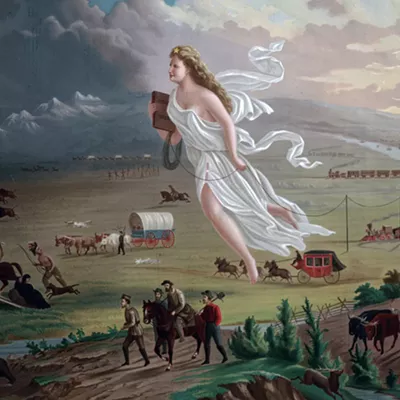Lumber, ore and trains made Spokane what it was a century ago, with rails allowing the transport of natural resources. And if you hearken back to Spokane after the big fire of 1889, you could have jumped on a horse-drawn rail-guided carriage in Browne's Addition and traveled up Grand Avenue along a loop back to town for a nickel. When the odor of horse manure became too much, the Spokane system was then converted to Steam Dummies, and the route then ended up at the new Manito Park. Eventually the system was converted to quiet-running electric trolleys.
The heyday of the railroads peaked around 1920, at a time when the country's magnificent landscape and cities and townships had 250,000 miles of railway lines running through them.
Fast-forward history to now, with the single-occupancy vehicle the norm, and you have social commentators like James Kunstler and Seattle-based artist and train aficionado Craig Thorpe kicking and screaming about the lost opportunity to revitalize our freight, long-range passenger and interurban rail systems.
"Relating transportation systems to cultural health and renewal may require an enormous mental leap, but that is exactly the connection I make," says Thorpe, who will be in Spokane talking about trains this week. "Further, as an artist deeply concerned with the erosion of aesthetics and the national landscape, I see representational art as a critical key in establishing that connection."
Thorpe's work shows trains moving in the landscape and centered in thriving urban and rural communities. He's also a train expert who is working with the Cascadia Center, a transportation planning and development think tank driven to develop an interlinked rail system from Vancouver B.C., to Seattle and to Portland.
Antidote to Sprawl & r & "Nostalgic but irrelevant," says Thorpe. "The words aptly describe the current American view toward passenger trains. Yet the passenger train must be restored as a critical part of our cultural and social infrastructure, for while it might conjure nostalgic feelings, it is far from irrelevant. In fact, the passenger train is more than 'just an outmoded form of transportation' because it embodies and enables enduring values critical to societal well-being."
Kunstler and others discuss the loss of public space, the loss of human scale in our cities, right down to the individual building or home, and the loss of towns and cities with vibrant cores and walkable and livable neighborhoods that are linked by interurban rails.
Sprawl metastasized because of the automobile and the need to feed the beast's lifeline: roads. So for 80 years, we have been paving the country into our current position, as described in Asphalt Nation (by Jane Holtz Kay), The Geography of Nowhere (by Kunstler) and Suburban Nation (by Andres Duany, Elizabeth Plater-Zyberk and Jeff Speck). We've lost a cultural treasure because of the death of thousands of city and town train and trolley systems as well as interstate and transcontinental passenger train travel.
"As the use of automobiles proliferated, so did the public's taste for distractive or even destructive pursuits," writes Alfred Runte, author of several books including his most recent, Allies of the Earth: Railroads and the Soul of Preservation. (Thorpe's train art graces the book's cover.) "Lost... was that sense of community and shared responsibility that railroad travel had fostered."
Passenger trains have atrophied. City train lines have been intentionally gutted over the years. So today we have more than 47,000 miles of blacktop linking America's cities. First conceived in the 1930s to stimulate economic development and provide efficient defense transportation, the nation's interstate system -- officially sanctified as the Dwight D. Eisenhower National System of Interstate and Defense Highways -- serves the more than 240 million trucks, buses, motorcycles and passenger vehicles sputtering around the nation.
Road rage, the super-sized cup holder, personalized DVD players and cell-phone madness certainly fail to build community -- and that doesn't factor in the 2.8 million Americans injured and 42,800 killed in 2004 in motor vehicle crashes.
Averting a Crisis & r & The "long emergency" is the concept put forth by Kunstler in his book with the same title (The Long Emergency: Surviving the Converging Catastrophes of the 21st Century). It posits that America will be in a storm of ever-increasing gas costs because of the poor choices we've made since the 1950s that all centered our neighborhood growth, service economy, manufacturing expansion, culture and individual wants around sprawl, suburbia, highways and the automobile.
As a partial response to this emergency, revitalizing our train system, Thorpe and Kunstler argue, should be on the front burner of every politician's stove.
"We have a train system that the Bulgarians would be ashamed of," Kunstler said recently during a visit to Spokane. He also opined that the Democratic Party could connect with voters by bringing up the need to rebuild America's railroads in every press conference.
During his visit, Kunstler made it clear that a simple but grand and effective way to make Americans feel somewhat hopeful about their future would be to harness our wealth and the impetus of our own history of big projects -- such as the Marshall Plan, the national highway system and a space program -- into rebuilding our railway system to realign communities away from cars and sprawl.
Thorpe agrees: "The choices the auto has provided have driven us not only to the suburbs but also into societal denial. There is a deep irony here: While we vehemently defend the need for choice in all things -- including transport -- we have eliminated virtually all choices but the auto. Further, we simply refuse to see the implications of auto sprawl: from wasted energy, to destroyed landscape, to sacrificed aesthetics, to a lost sense of place, to isolation and even incivility."
Thorpe, who spent many years rendering architectural drawings before shifting to transportation, views his role as part Pied Piper, part New Urbanist in his campaign to work on the Cascadia Center's vision. The tens of millions of lost dollars each year and daily lives stuck in vehicles because of traffic gridlock are parts of the reason the Cascadia Center sees more and more urban designers, traffic planners, economic development specialists and governments willing to put down billions for a rail system that will service Vancouver, Seattle, Portland and routes east.
An economic incentive for fortifying mass transit and train links is a recent movement in planning called "transit-oriented developments" and "transit-adjacent housing," which are basically compact, mixed-use communities or portions of a city's outer core where people want to ditch their personal vehicles for vibrant neighborhoods that are linked to a city center's amenities without struggling to deal with gassing up, driving, gridlock and parking.
"We are talking about a true lifestyle based on the concept of high usage of public transportation," says Michael Wohl, a Florida developer with big plans for the Sheridan Street park-and-ride lot that abuts the tracks in Hollywood, Fla.
We have Portland as a regional example of a community working to handle the challenges of population growth, a suburban building boom, more cars and occluded roadways with its interlinked bus lines and light rail Metropolitan Area Express (MAX), which covers more than 44 rail miles throughout metropolitan Portland.
"Portland, Denver, Salt Lake, Sacramento and Dallas are just a few of the cities experiencing the financial and social benefits of rail. In spite of the naysayers, people are flocking to the rails," Thorpe states. "Minneapolis's new Hiawatha service is experiencing double the pre-construction ridership forecasts. Some 70 cities are now lined up in a coalition supporting Oregon's Congressman Earl Blumenauer's legislation to streamline funding for streetcar systems, which enhance mobility and tread lightly on the landscape."
Curbing the Car & r & Spokane and the Inland Northwest are struggling with population growth. One study showed that the on-again, off-again light-rail line proposed between downtown Spokane and Liberty Lake (perhaps to be run to Coeur d'Alene and the Spokane International Airport) could bring 16,000 new jobs and increase nearby property values by $780 million over the next 20 years.
Mass transit is not only vital to the affluent who choose to leave their cars at home more often, but it can be the difference between living in or out of poverty for those who just can't afford to own a car.
As Kunstler points out, however, curbing car culture will not be a pretty negotiation. Vice President Dick Cheney weighed in on the argument, making it clear in a rare press conference right after September 11, 2001, that the American way of life -- cars and suburbs and goods from China -- "is not negotiable."
Thorpe makes his case on canvas, conveying how North America -- the land as well as the collective consciousness -- can be enhanced by reinvigorating the rail system.
"Contemporary culture may ridicule or ignore the passenger train, at least for the moment," Thorpe says. "But the modern [way] can only go so far. What it will take to move us into serious discussion and acceptance is yet unseen. Will it be a political, environmental, economic or worsening social crisis? Perhaps an unexpected opportunity? We do not know. Yet new leadership -- showing boldness, vision and creativity -- is happening upon the scene. I am sure that rail art, in its ironic and iconic juxtaposition of style and content, will add to the momentum for passenger trains to once again teach us the experience of life and land -- beyond nostalgia."
Railroad artist Craig Thorpe will be giving a lecture and slide show at Spokane Falls Community College on Wednesday, Jan. 11, at 11:30 am at Spokane Falls Community College's SUB A & amp; B.















